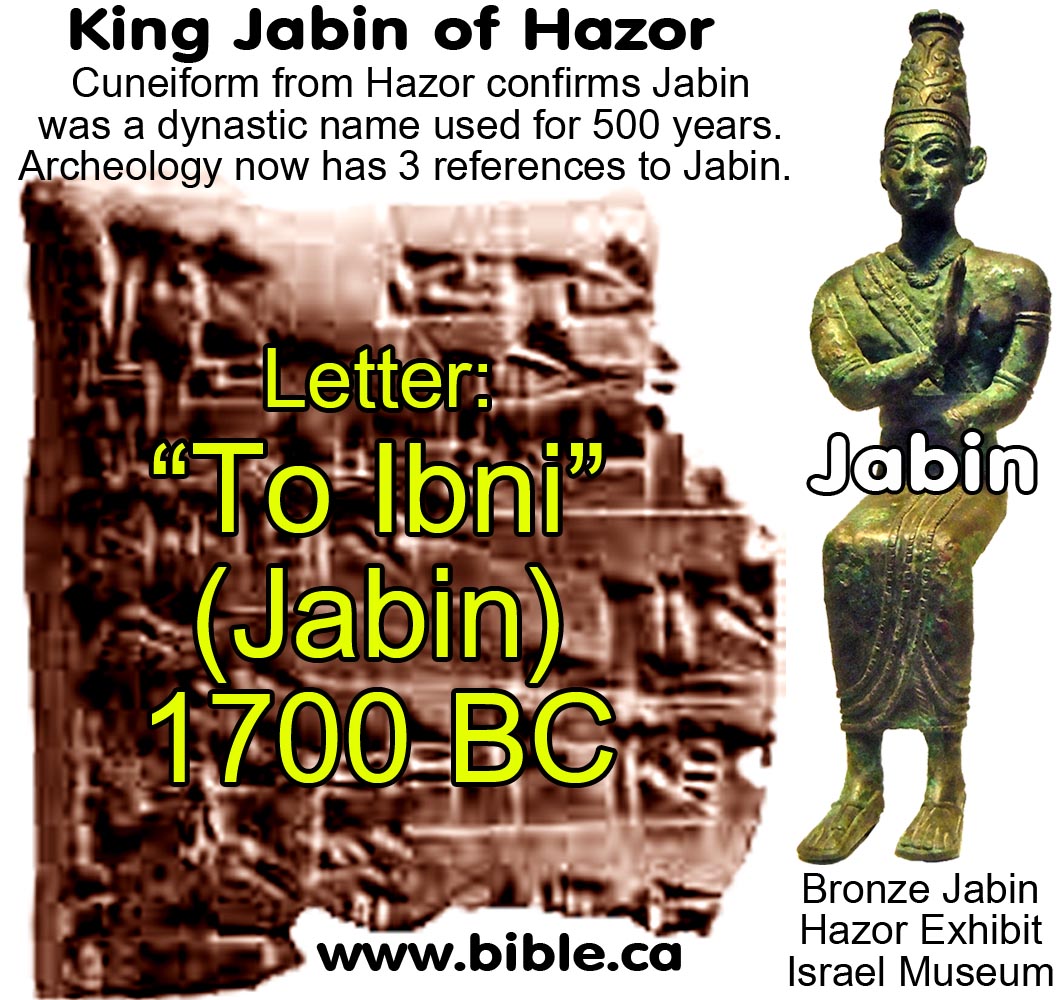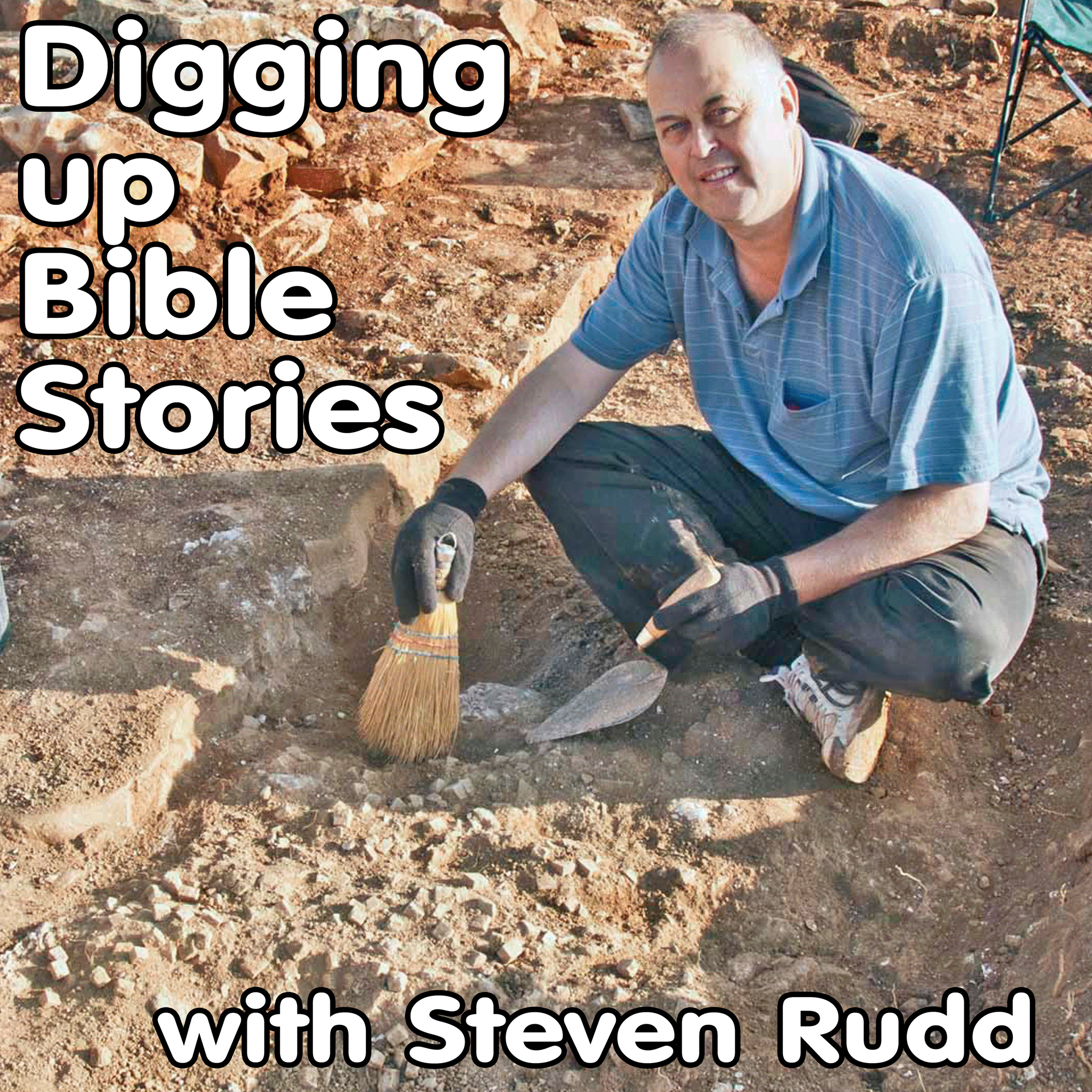Archaeologists are digging up bible stories:
King Jabin found in three different inscriptions: 1700-1200 BC
|
|
|
|
Five different references to Jabin of Hazor Archeology now has uncovered a total of three different references to Jabin, in addition to the two Bible references to Jabin of Joshua (1406 BC) and Deborah (1200 BC). This proves the Bible was right all along and that "Jabin" is a dynastic name for a series of kings rather than the one time use of a single king. Two 18-17th century inscriptions have been found at Mari and Hazor with the name Jabin. A third is on the names list of Ramesses II at the Amon Temple at Karnak 1279-1212 BC. 1. The Accadian tablet from Mari reads: “Ibni-Addad king of Hazor.” (18th century BC) 2. The Old Babylonian tablet letter from Hazor is actually addressed "To Ibni". (18-17th century BC) 3. The Ramseese II namelist at Karnak reads: "Qishon of Jabin" |
|
|
Archaeologists are digging up bible stories!!! |
|
|
Archaeology is an important science that confirms the historical accuracy of the Bible. Since the Bible refers to hundreds of cities, kings, and places, we would expect to find evidence from on-site excavations. And this is exactly what we have found. The Bible is the most historically accurate book of history on earth. Read the Bible daily! |
|
|
|
|
Discussion:
1. The Bible refers to two different kings of Hazor with the same name: Jabin:
a. 1402 BC: “Then it came about, when Jabin king of Hazor heard of it, that he sent to Jobab king of Madon and to the king of Shimron and to the king of Achshaph,” (Joshua 11:1)
b. 1200 BC: “And the Lord sold them into the hand of Jabin king of Canaan, who reigned in Hazor; and the commander of his army was Sisera, who lived in Harosheth-hagoyim.” (Judges 4:2)
2. Hazor was a very important capital city like Washington or Ottawa:
a. “Then Joshua turned back at that time, and captured Hazor and struck its king with the sword; for Hazor formerly was the head of all these kingdoms. They struck every person who was in it with the edge of the sword, utterly destroying them; there was no one left who breathed. And he burned Hazor with fire.” (Joshua 11:10–11)
b. This proves the Bible was right all along and that "Jabin" is a dynastic name for a series of kings rather than the one time use of a single king. There were many Thutmoses pharoah's from the 18th dynasty and many Ramaases from the 12th dynasty. Now we know that the king of Hazor was the name of many kings who ruled in succession for over 500 years!
c. Just as there are many men called "President" or "Prime Minister" so too there were many men called Thutmoses, Ramaases and Jabin!
3. "Ibni (Jabin?), King of Hazor: Babylonian Tablet Confirms Biblical Name: The first reference to Jabin is the list of Canaanite placenames at the temple at Karnak contains the name Qishon of Jabin. A second reference to Jabin has now apparently been found at Hazor, where excavators discovered a fragment of a royal letter addressed “To Ibni,” a name similar in derivation to Jabin. Dating to the 18th–17th centuries B.C.E., this cuneiform fragment measures 1.18 by 1.06 inches and is written in Old Babylonian. The few phrases that survive record objections raised over the transfer of a young woman." (Exodus Itinerary Confirmed by Egyptian Evidence, Charles R. Krahmalkov, BAR 20:05, Sep/Oct 1994 AD)
4. "Name Of Jabin Found At Hazor: A fragment of a clay tablet addressed to Jabin, king of Hazor, was found this past summer in excavations at Hazor. Although the Jabin of the tablet is neither of the Jabins mentioned in the Bible, it attests to the fact that Jabin was a dynastic name at Hazor. The king of Hazor at the time of the Conquest in ca 1406 BC was named Jabin according to Joshua 11:1. In the days of Deborah and Barak, nearly 200 years later, the name of the king of Hazor was also Jabin (Jgs 4; Ps 83:9). This has been a problem to Biblical scholars. If Jabin was killed and his city burned by the Israelites at the time of the Conquest, how could Deborah and Barak battle Jabin king of Hazor nearly 200 years later? The solutions proposed by critics are numerous, but they all assume one thing: the Bible has things mixed up here and there must be a textual problem. The obvious solution is that there were two different kings with the same name. But scholars never consider that possibility; the Bible must be wrong, they assert. The carrying on of dynastic names was a common practice in antiquity and is well attested. The fact that there were 11 kings in Egypt with the name Ramesses is readily accepted by historians, but if there are two kings with the same name in the Bible, that becomes a major textual problem! Thanks to the discoveries of archaeology, it is now clear that the name Jabin at Hazor was a dynastic name used over many centuries. Rather than being a problem, the Bible’s use of this name for the kings of Hazor reflects an intimate knowledge of the politics of Canaan in the Late Bronze Age. The first extra-Biblical reference to a king named Jabin at Hazor was found at Mari. A text from the 18th century BC records shipments of tin from Mari to “Ibni-Addad king of Hazor.” The form of the name in this text is Accadian; the West Semitic form would be “Yabni-Haddad.” Biblical Jabin (Yabin) is simply a shortened form of this same name. The newly discovered second extra-Biblical reference to a king named Jabin at Hazor was a tablet found at Hazor, and is 2x2 cm (less than 1x1 in) and represents less than half the original. Written in Old Babylonian, and thus dated to the 18th-17th centuries BC, it is addressed to Ibni-Addu, king of Hazor. Again, the name Ibni corresponds to Jabin (Yabin) in the Bible. The letter was written by an appointee of the king and concerns the transfer of a woman from one place to another. Exhibiting a high-quality style and writing, the clay tablet unquestionably was a royal document executed by a skilled scribe." (Name Of Jabin Found At Hazor, Bible and Spade 1992 AD)
5. "After Thutmose III (1504–1450 b.c.) and well into the 19th Dynasty, expeditions to Nubia are mentioned frequently in the sources. Under a peaceful and efficient administration, the region prospered with the construction of irrigation works, the founding of new cities, and the erection of at least a dozen new temples, many of great size. The finest of the temples was built by Amenhotep III (1417–1379 b.c.) at Soleb; although reminiscent of his lovely temple at modern Luxor with its closed papyrus columns, it is sadly ruined today." (Ethiopia, The International Standard Bible Encyclopedia, Vol 2, p194, 1988 AD)
By Steve Rudd: Contact the author for comments, input or corrections.


